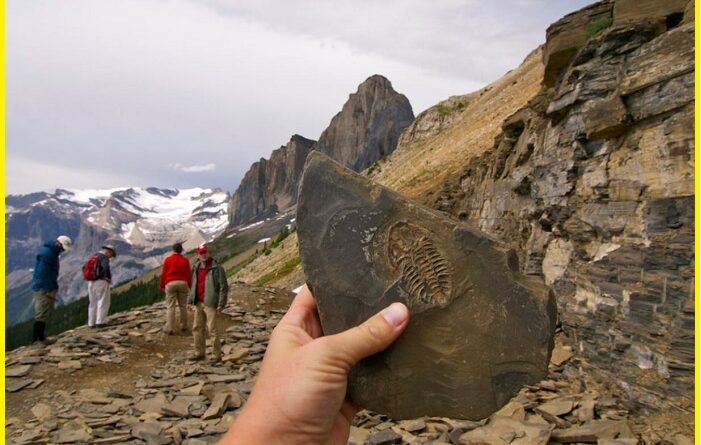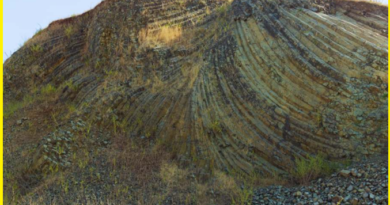Burgess Shale-A 505 Million years Old Fossils in British Columbia
Burgess shale
The Burgess Shale is a fossil-rich deposit located in the Canadian Rockies of British Columbia. It is famous for preserving a wide variety of soft-bodied organisms from the Middle Cambrian period, about 505 million years ago, providing a unique glimpse into early animal life. The fossils found in the Burgess Shale are some of the most important and well-known examples of the Cambrian Explosion, a time when the diversity of animal life rapidly increased.
The fossils have helped to expand our understanding of early animal evolution, as they provide evidence of previously unknown species, many of which had complex body structures and behaviors. This site has also shed light on the origins of major animal groups, such as arthropods and chordates, and has challenged previous notions about the evolutionary relationships between different species.
The Burgess Shale is an important site for scientific study, and new fossils are still being discovered and analyzed. It has been designated a UNESCO World Heritage site and is protected as a national park in Canada to preserve this unique and valuable paleontological resource for future generations.
Burgess shale hike
The Burgess Shale is located in Yoho National Park in the Canadian Rockies. There is a popular hiking trail called the Burgess Shale Geological Reserve Trail, which leads visitors to the site where the fossils were first discovered. This trail is considered to be a challenging hike, with steep inclines and rough terrain, but the journey is rewarded with breathtaking views of the surrounding mountains and valleys.
The hike typically takes 6-8 hours round-trip, and it is important to be prepared for the conditions, which can change quickly in the mountains. Visitors should bring plenty of water, food, and warm clothing, as well as sturdy hiking shoes. Additionally, it is important to follow Leave No Trace principles and respect the sensitive and protected environment of the Fossils site.
Visitors who would like to learn more about the Fossils site and its significance can also visit the nearby Field Visitor Centre, which provides information on the geological and paleontological history of the area.

Burgess shale fossils
The Burgess Shale dates back to the Middle Cambrian period, about 505 million years ago. It is famous for preserving a remarkable variety of soft-bodied organisms, including many that were previously unknown. The fossils provide valuable insight into the early evolution of animal life on Earth.
Burgess shale animals include a wide range of organisms, from simple, worm-like creatures to more complex animals with segmented bodies, multiple appendages, and hard exoskeletons. Some of the most famous fossils include:
- Marrella: A small arthropod with a segmented body and delicate legs.
- Anomalocaris: A large, predatory arthropod with a circular mouth surrounded by razor-sharp spines.
- Hallucigenia: A mysterious creature with elongated spikes or spines running down its back and a series of appendages along its sides.
- Wiwaxia: A soft-bodied, segmented animal covered in spines and scales.
- Opabinia: A bizarre, five-eyed creature with a long, narrow head and a hose-like nozzle for a mouth.
These fossils have helped to expand our understanding of early animal evolution, and have challenged previous notions about the relationships between different species. The site continues to be an important site for scientific research, as new fossils are still being discovered and analyzed.
Also, read- Red Rock Coulee-A Magnificent badlands formation in Alberta
Burgess Shale Fossil beds
The Burgess Shale fossil beds consist of a series of rock formations that were formed from sediment that settled on the seafloor more than 500 million years ago. Over time, the sediment was buried and subjected to heat and pressure, causing the organic material to become fossilized. The fossils are unique because they preserve not only the hard parts of animals, such as shells and bones but also the soft tissues, such as muscles and internal organs, that are typically not preserved in the fossil record.
The Burgess Shale fossil beds in Canada preserve this unique and valuable paleontological resource for future generations. The site continues to be an important location for scientific research, as new fossils are still being discovered and analyzed.

Burgess Shale Tours
There are several tours available that allow visitors to see the Burgess Shale and learn about the fossils and the geological formations in which they are preserved. Some of these tours are day trips, while others are multi-day hikes or camping trips that take visitors into the remote backcountry of the Canadian Rockies.
Here are a few popular Burgess Shale tours-
Yoho National Park Burgess Shale Guided Hike: A guided day hike through Yoho National Park, with a visit to the fossil beds and an introduction to the geology and paleontology of the area.
- Burgess Shale and Mount Stephen Tramway: A tramway ride to the top of Mount Stephen, followed by a guided hike to the fossil beds.
- Mount Stephen Fossil Beds: A guided hike to the Mount Stephen fossil beds, with an in-depth look at the fossils and the geological formations in which they are preserved.
- Backcountry Burgess Shale: A multi-day backpacking trip that takes visitors deep into the Canadian Rockies to see the Shale site and other remote fossil beds.
Visitors should keep in mind that The Place is located in a remote and rugged area of the Canadian Rockies and that some tours may involve challenging hiking and camping. It is important to be properly equipped and prepared for the conditions and to follow all safety guidelines provided by the tour operators.
How to Reach Fossils Site
The Burgess Shale is located in the Canadian Rockies of British Columbia, Canada, near the town of Field. The easiest way to reach the Fossils site is by car. The field is located approximately 2.5 hours from Banff, Alberta, and 4 hours from Calgary, Alberta, along the Trans-Canada Highway.



